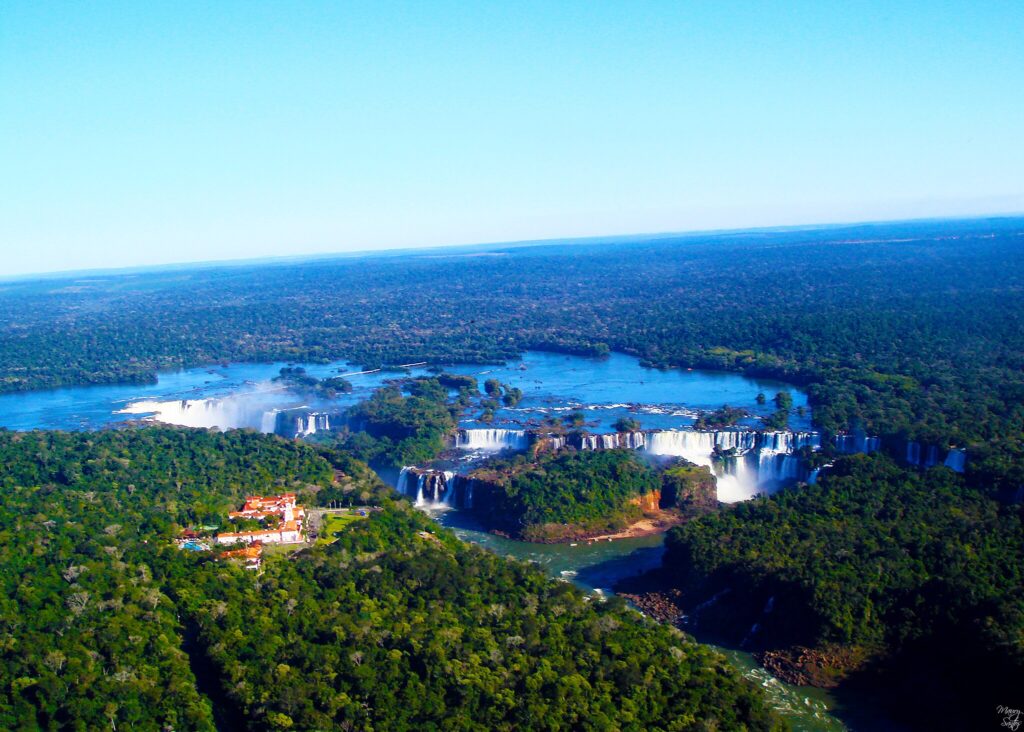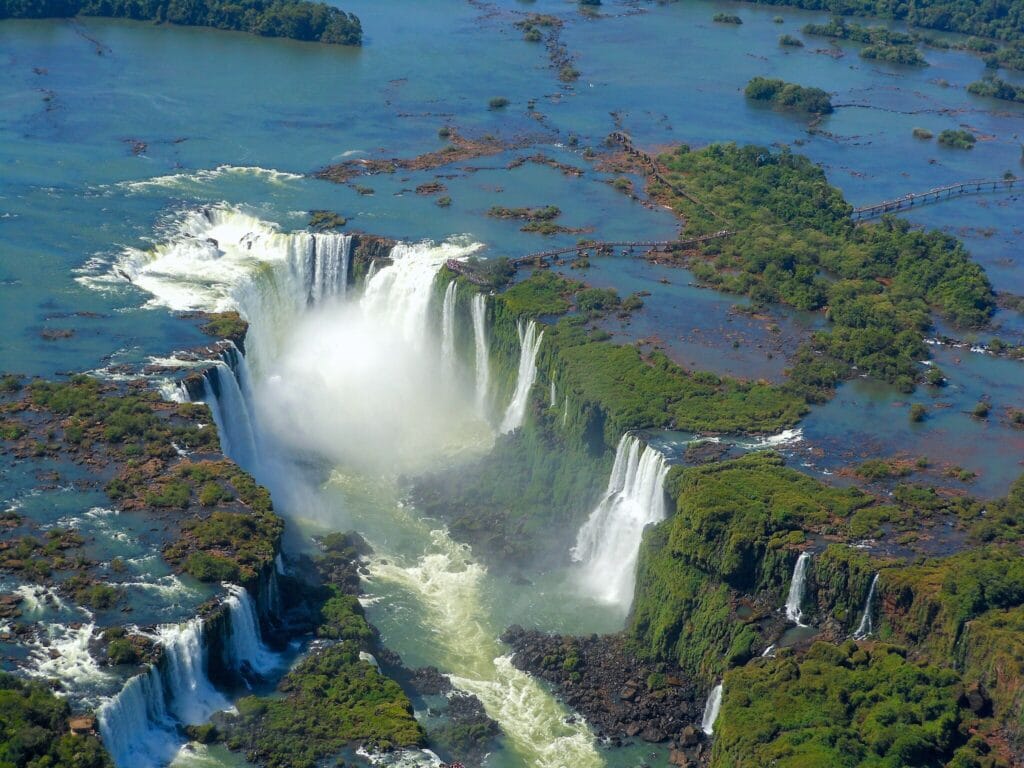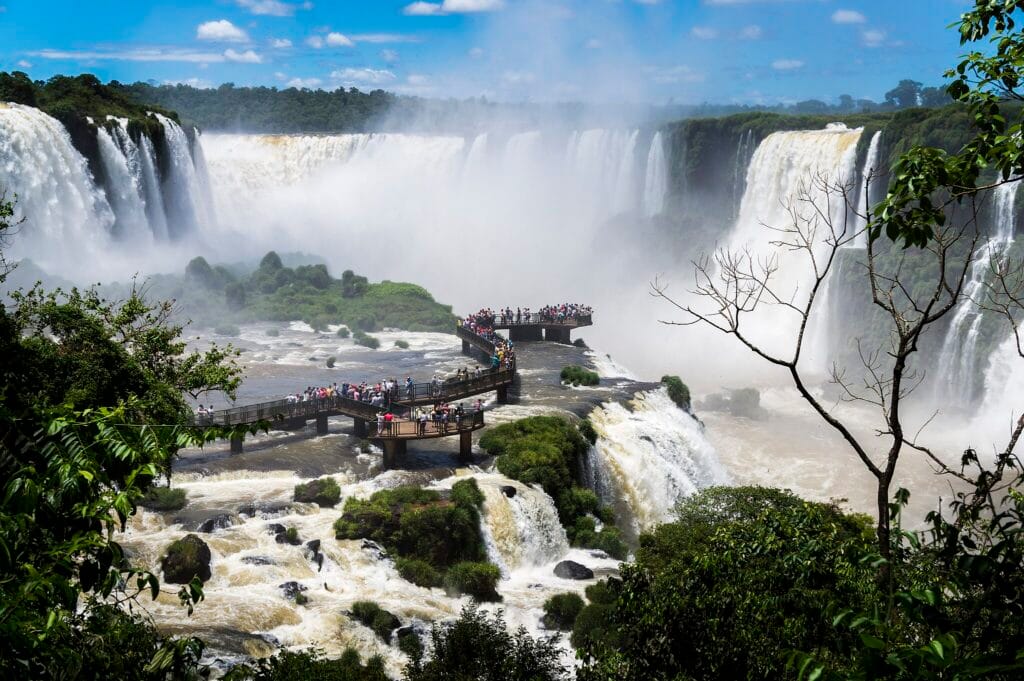Iguaçu National Park, Waterfalls and Wildlife
Iguaçu National Park is a beautiful destination that attracts nature lovers and experience seekers from around the world. One of its main attractions is the Iguaçu Falls, which sits on the border between Brazil and Argentina and is known as one of the most impressive waterfalls in the world. The Park is home to a wide variety of plants and animals, including impressive jaguars, sneaky ocelots, and numerous types of birds. With its breathtaking scenery and rich wildlife, Iguaçu National Park offers a memorable experience for anyone looking to explore the wonders of nature.
Table of Contents
Where is the location of Iguaçu National Park?
Iguaçu National Park is in Brazil, close to the border with Argentina. It shares a border with Iguazú National Park in Argentina, making a large area of protected forest that is home to many types of plants and animals. Located in the state of Paraná, the park is well-known for its beautiful waterfalls and diverse wildlife.
Inscription of Iguaçu National Park
Iguaçu National Park was recognized as a UNESCO World Heritage Site in 1986, highlighting its importance to people around the world. This recognition shows that the Park is not only stunningly beautiful but also plays a crucial role in protecting a wide variety of plants and animals. Being recognized as a World Heritage Site serves as an important reminder of how essential it is to preserve the Park’s unique environments. Iguaçu National Park is a special place that inspires hope for conservation efforts all over the globe.
What is Iguaçu National Park?

Iguaçu National Park is situated in the southern part of Brazil, specifically in Paraná state. It’s located at the point where the Iguaçu and Paraná rivers converge, close to the borders of Paraguay and Argentina. The Iguaçu (or Iguazú) River, which translates to “great water” in the Indigenous language, flows in a curve between two parks. It acts as the boundary between Argentina and Brazil before merging with the Paraná River, which is about 25 kilometers downstream from the park.
The Park is famous for housing Iguaçu Falls (Cataratas do Iguaçu), one of the largest and most stunning waterfall systems in the world. Both Iguaçu National Park and the nearby Iguazú National Park in Argentina are celebrated as a World Heritage Site, highlighting their incredible natural beauty and significance. The total area of the parks in Brazil and Argentina is about 250,000 hectares, and this particular property makes up 169,695.88 hectares. The land was formed by volcanic activity over 500 million years ago, which has given it unique geological features.
This site is a significant part of the original Atlantic Forest, which used to be a large and vibrant forested region. The Parks are home to lush, subtropical rainforests filled with many plants and animals, many of which are unique and hard to find. You can spot some rare and exciting creatures there, like the giant otter and anteater, which are not very common in other places. The whole area is known for its unique wildlife and beautiful greenery.
What is the Iguaçu Falls famous for?

Iguaçu Falls is one of the most amazing natural sights in South America and draws many visitors from around the world. The falls are situated along the Iguaçu River, which marks the border between the Brazilian state of Paraná and the Argentine province of Misiones. It is one of the largest and most stunning waterfalls on the planet, stretching over 2,700 meters wide. This beautiful landmark can be found within Iguaçu National Park in Brazil and Iguazú National Park in Argentina, making it a shared treasure between the two countries.
The waterfalls are famous for their stunning views and relaxing sounds. They flow for nearly three kilometers and plunge down as much as 80 meters! Nestled in lush, tropical rainforests, these waterfalls support a variety of wildlife, such as jaguars, butterflies, birds, and coatis. The mist from the falls also helps many plants thrive in the area. Visiting these waterfalls provides a wonderful opportunity to experience the beauty and power of nature.
What is the biodiversity of Iguaçu National Park?
Iguaçu National Park is connected to Iguazú National Park in Argentina. It is one of the last protected areas of the subtropical forest known as the Paranaense, which is part of the larger Atlantic Forest. This park is significant for the environment and helps protect various plant and animal life.
The variety of living beings on our planet includes some animals that are in danger of disappearing, along with others that are vulnerable to threats. These at-risk species include the Jaguar, Ocelot, Puma, Margay, Jaguarundi, Harpy Eagle, Giant Otter, and Bush Dog. It’s important to recognize and protect these animals to help maintain our Earth’s biodiversity.
What is the Iguaçu National Park famous for?
Iguaçu National Park is famous for its stunning waterfalls, particularly the Iguaçu Falls, which are one of the largest and most impressive waterfall systems in the world. The park is located on the border of Brazil and Argentina and is known for its breathtaking views and diverse wildlife. It is a UNESCO World Heritage Site that offers opportunities for hiking, birdwatching, and experiencing the rich biodiversity of the Atlantic Rainforest. The park’s dramatic landscapes and natural beauty make it a popular destination for visitors from around the globe.
Why do we need to preserve Iguaçu National Park significantly for us and future generations?
Preserving Iguaçu National Park is vital for both current and future generations due to its rich biodiversity and unique ecosystems. The park is home to many endangered species and serves as a critical habitat that helps maintain ecological balance. Additionally, it offers important resources such as clean air and water and plays a crucial role in climate regulation.
By protecting this natural wonder, we not only safeguard its beauty and cultural heritage but also ensure that new generations can appreciate and benefit from its natural resources and recreational opportunities. Preserving Iguaçu National Park is essential for sustaining our planet’s health and diversity.
Why should you visit the Iguaçu National Park as a visitor?

Iguacu National Park is a fantastic place for anyone who loves nature and adventure. It features the incredible Iguazu Falls, which are among the largest and most beautiful waterfalls in the world. In the park, you can enjoy amazing views of the waterfalls, explore lush rainforests, and spot various animals. It’s a great spot to experience the beauty of the outdoors. Plus, Iguacu National Park is recognized as a UNESCO World Heritage site, making it a special place to appreciate nature’s wonders.
Are you ready to explore the rich biodiversity of Iguaçu National Park and Iguaçu Falls, home to fantastic wildlife and lush rainforests?
Don’t miss out on the adventure of a lifetime! Plan your trip to Iguaçu National Park today and experience the majestic power of nature, the incredible wildlife, and unforgettable memories. Book your tickets now and get ready for an experience that will leave you in awe!
When you’re planning your adventure, enhance your travel experience by using trusted websites like GetYourGuide, Trip.com and Agoda! These platforms offer a variety of enjoyable tours, activities, and accommodation options to suit every traveler’s needs.
- GetYourGuide offers a wide variety of unforgettable travel experiences. You can choose from tickets to Popular Attractions, Transportation Options, City Passes, Guided Tours, Hop-on Hop-off Bus Services, Water Activities, Day trips, and Trips that last several days in many locations around the world.
- Trip.com makes it easy to combine Flights and Hotels, Trains, Car Rentals, Airport Transfers and Attractions & Tours to create the perfect travel package tailored just for you.
- Agoda offers a wide range of accommodations and travel options to suit your needs. With user-friendly search features, you can easily find the perfect Hotel, Apartment, or Villa, Flights, Activities and Airport Transfer at competitive prices.
Start your journey with our reliable travel partners and unlock the best of Iguaçu National Park and beyond!
Disclaimer
In this post, affiliate links are included and those links are associated with well-known travel companies such as GetYourGuide, Trip.com and Agoda. If you choose to purchase or book a service using those links, we may earn a commission at no additional cost to you. We focus on recommending products and services that are helpful to you and we appreciate your support!
Conclusion
We hope you find this information helpful for your next trip. If you want to learn more, check out our other travel blog posts. We cover many topics, including amazing places to visit and helpful travel tips. Whether you’re looking for hidden gems, new cultures, or helpful advice, there’s something for everyone.
Additionally, if you enjoyed the information we shared, don’t forget to explore our other travel product reviews to make your journey even better! Please take a moment to look through our previous posts and let your sense of adventure guide you on your next journey! We wish you happy travels and look forward to sharing more with you in our next blog post!




